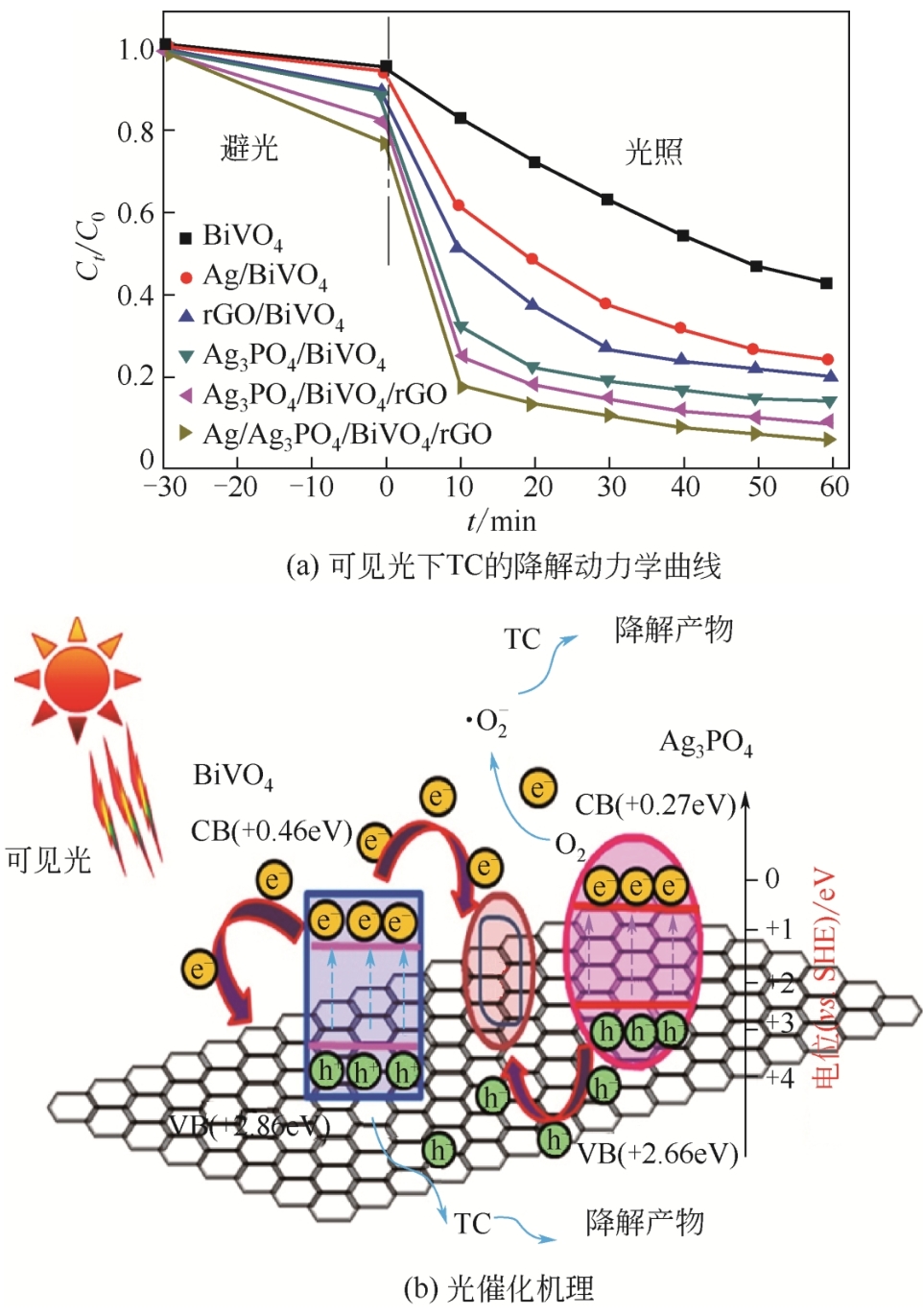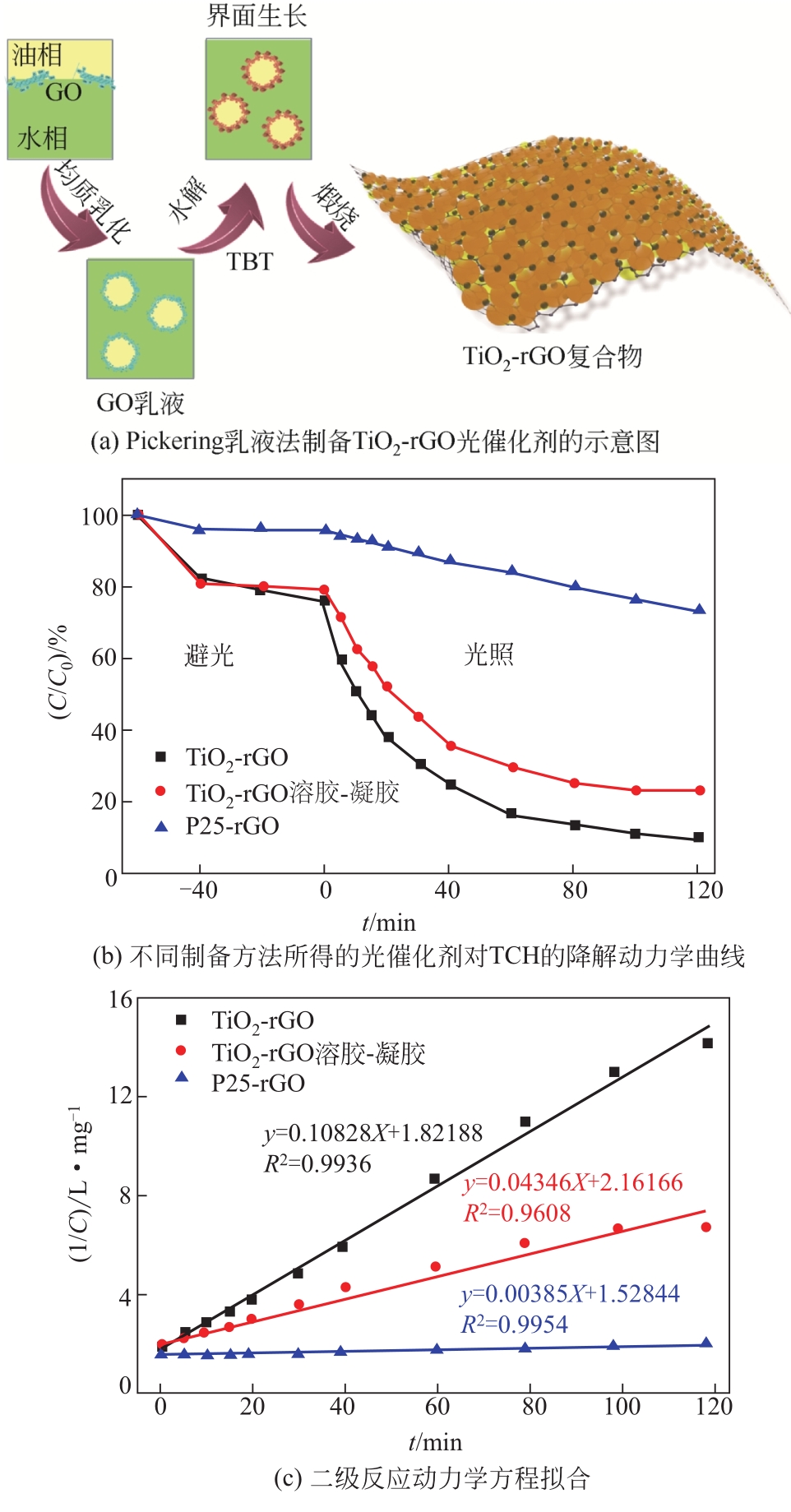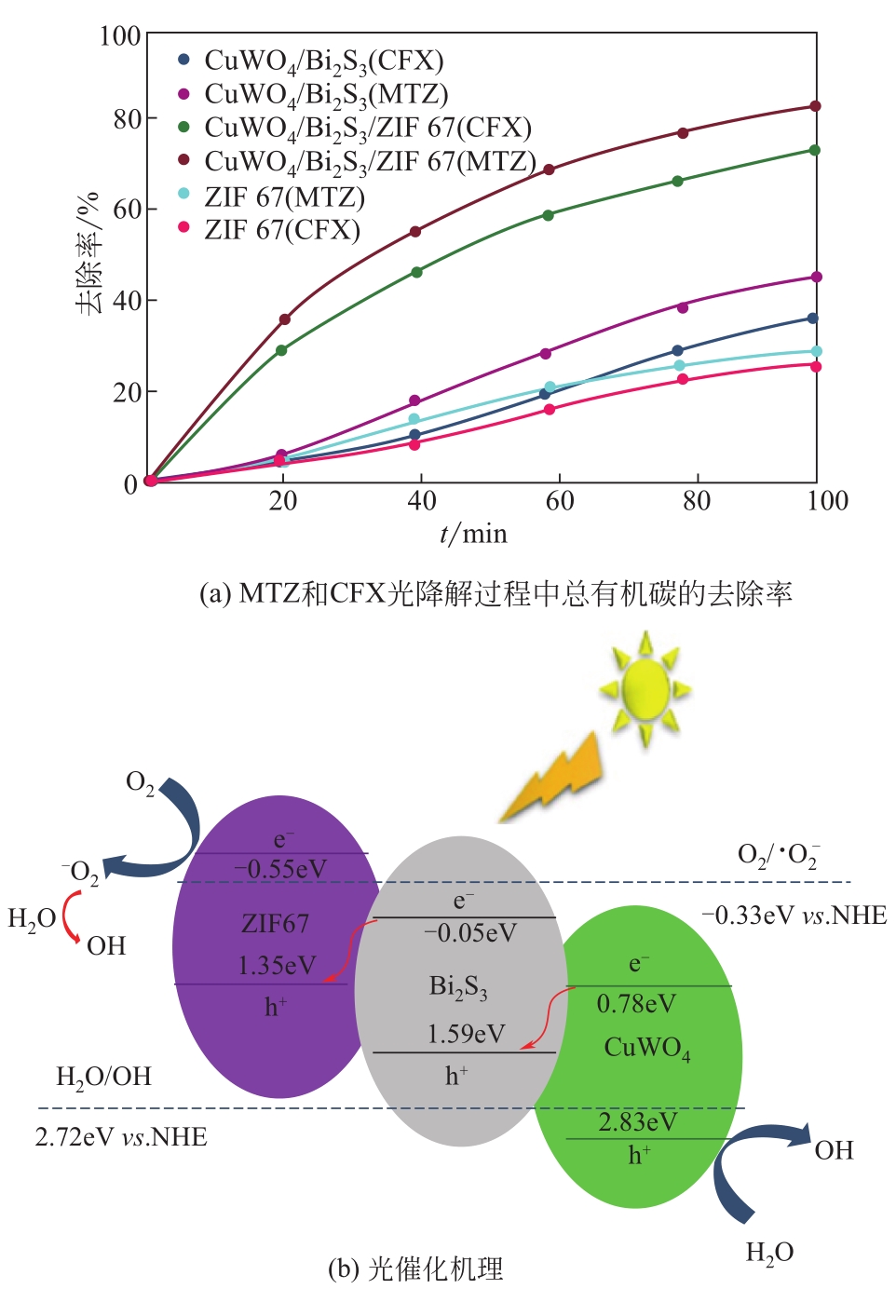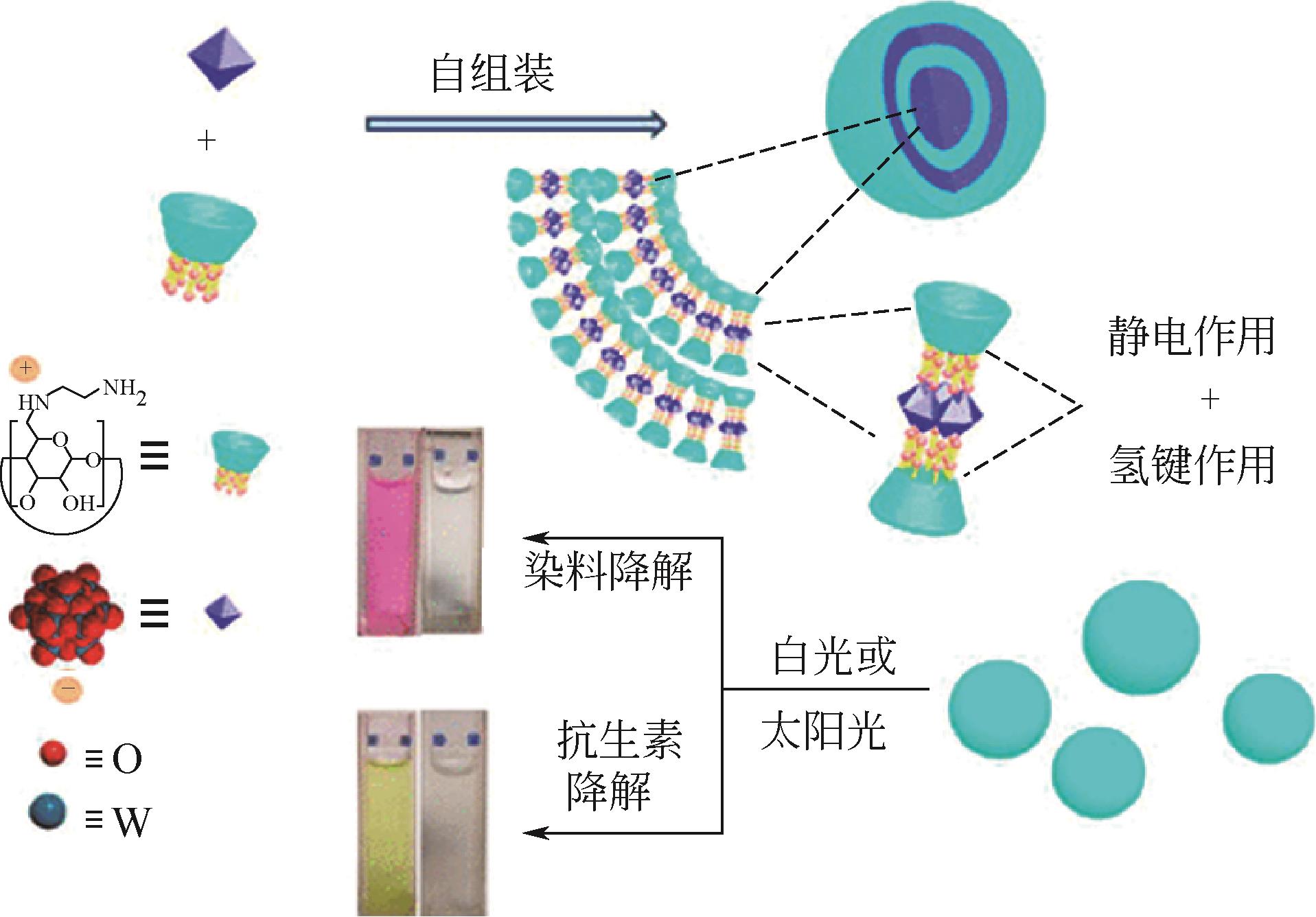化工进展 ›› 2021, Vol. 40 ›› Issue (6): 3287-3299.DOI: 10.16085/j.issn.1000-6613.2020-1336
基于孔材料的多元复合光催化剂降解抗生素
张申平1,2( ), 王艺蒙1, 葛宇2, 胡军1(
), 王艺蒙1, 葛宇2, 胡军1( ), 刘洪来1
), 刘洪来1
- 1.华东理工大学化学与分子工程学院,上海 200237
2.上海市质量监督检验技术研究院,上海 200233
-
收稿日期:2020-07-13修回日期:2020-09-28出版日期:2021-06-06发布日期:2021-06-22 -
通讯作者:胡军 -
作者简介:张申平(1992—),男,博士,研究方向为光催化降解污染物。E-mail:zhang_shenping@163.com 。 -
基金资助:国家自然科学基金(91834301)
Degradation of antibiotics by porous composite photocatalyst
ZHANG Shenping1,2( ), WANG Yimeng1, GE Yu2, HU Jun1(
), WANG Yimeng1, GE Yu2, HU Jun1( ), LIU Honglai1
), LIU Honglai1
- 1.School of Chemistry and Molecular Engineering, East China University of Science and Technology, Shanghai 200237, China
2.Shanghai Institute of Quality Inspection and Technical Research, Shanghai 200233, China
-
Received:2020-07-13Revised:2020-09-28Online:2021-06-06Published:2021-06-22 -
Contact:HU Jun
摘要:
多孔复合材料光催化体系集多孔材料的吸附性能和光催化活性,可将水体中浓度较低的抗生素富集在光催化活性位表面进行高效降解,同时吸附性能得以原位再生。通过对光催化活性体与载体的结构调控,可获得更宽的吸光范围(包括可见光)且有效抑制光生电子-空穴对复合。本文总结了基于新型多孔材料包括石墨烯、金属有机框架材料(MOFs)、多孔有机聚合物(POPs)等与传统半导体构筑的多元光催化体系及其对水体中抗生素等有机污染物光降解的最新研究进展,阐述了多元光催化体系设计思路、降解过程优化控制因素、抗生素降解去除性能及其产生优异性能的机理。此外,还总结了当前复合光催化剂在结构设计和性能评价层面存在的问题,最后对光催化材料的研究方向进行了展望,借助光响应的多孔有机聚合物提升复合光催化剂性能以及粉末光催化剂材料的工程化应用探究将有效促进光催化技术的发展。
中图分类号:
引用本文
张申平, 王艺蒙, 葛宇, 胡军, 刘洪来. 基于孔材料的多元复合光催化剂降解抗生素[J]. 化工进展, 2021, 40(6): 3287-3299.
ZHANG Shenping, WANG Yimeng, GE Yu, HU Jun, LIU Honglai. Degradation of antibiotics by porous composite photocatalyst[J]. Chemical Industry and Engineering Progress, 2021, 40(6): 3287-3299.
| 类别 | 单一半导体光催化剂 | 复合光催化剂 |
|---|---|---|
| 主要组成 | 金属氧化物、磷化物、硫化物等 | 石墨烯等碳材料、MOFs、POPs等与半导体材料的复合物 |
| 形貌 | 微小颗粒、纳米线、纳米阵列等 | 片层结构,MOFs、POPs有序的三维结构,部分线性POPs |
| 结晶度 | 结晶度高,衍射峰窄 | 衍射峰较宽,多为无定型,MOFs除外 |
| 比表面积 | 较低,从几到几十m2/g不等 | 从几百到数千m2/g不等 |
| 抗生素吸附性能 | 物理吸附为主,大部分材料吸附量≤10mg/g | π-π堆积、静电引力、氢键等多重相互作用,吸附量高,几十到数百mg/g不等 |
| 光吸收性能 | 绝大部分仅吸收紫外光,光利用率低 | MOFs、POPs等基于—NH2、—SH等官能团对400~800nm可见光吸收较强 |
| 光稳定性 | 金属硫化物光腐蚀较为严重 | 基于多组分之间的光生电子-空穴对的分离和传递,光稳定性高 |
表1 单一半导体光催化剂和复合光催化剂对比
| 类别 | 单一半导体光催化剂 | 复合光催化剂 |
|---|---|---|
| 主要组成 | 金属氧化物、磷化物、硫化物等 | 石墨烯等碳材料、MOFs、POPs等与半导体材料的复合物 |
| 形貌 | 微小颗粒、纳米线、纳米阵列等 | 片层结构,MOFs、POPs有序的三维结构,部分线性POPs |
| 结晶度 | 结晶度高,衍射峰窄 | 衍射峰较宽,多为无定型,MOFs除外 |
| 比表面积 | 较低,从几到几十m2/g不等 | 从几百到数千m2/g不等 |
| 抗生素吸附性能 | 物理吸附为主,大部分材料吸附量≤10mg/g | π-π堆积、静电引力、氢键等多重相互作用,吸附量高,几十到数百mg/g不等 |
| 光吸收性能 | 绝大部分仅吸收紫外光,光利用率低 | MOFs、POPs等基于—NH2、—SH等官能团对400~800nm可见光吸收较强 |
| 光稳定性 | 金属硫化物光腐蚀较为严重 | 基于多组分之间的光生电子-空穴对的分离和传递,光稳定性高 |
| 1 | János BÉRDY. Thoughts and facts about antibiotics: where we are now and where we are heading[J]. The Journal of Antibiotics, 2012, 65(8): 385-395. |
| 2 | JI Kyunghee, Younglim KHO, PARK Changu, et al. Influence of water and food consumption on inadvertent antibiotics intake among general population[J]. Environmental Research, 2010, 110(7): 641-649. |
| 3 | GARETH Lepage, LINA Gunnarsson, JASON Snape, et al. Integrating human and environmental health in antibiotic risk assessment: a critical analysis of protection goals, species sensitivity and antimicrobial resistance[J]. Environment International, 2017, 109: 155-169. |
| 4 | HAN Yiru, WANG Qiaojun, MO Cehui, et al. Determination of four fluoroquinolone antibiotics in tap water in Guangzhou and Macao[J]. Environmental Pollution, 2010, 158(7): 2350-2358. |
| 5 | 陶玉强, 赵睿涵. 持久性有机污染物在中国湖库水体中的污染现状及分布特征[J]. 湖泊科学, 2020, 32(2): 309-324. |
| TAO Yuqiang, ZHAO Ruihan. Occurrence and distribution of persistent organic pollutants in water of Chinese lakes and reservoirs[J]. Journal of Lake Sciences, 2020, 32(2): 309-324. | |
| 6 | CALVETE Mário J F, PICCIRILLO Giusi, VINAGREIRO Carolina, et al. Hybrid materials for heterogeneous photocatalytic degradation of antibiotics[J]. Coordination Chemistry Reviews, 2019, 395: 63-85. |
| 7 | NOVOESLOV K S, GEIM A K, MOROZOV S V, et al. Electric field effect in atomically thin carbon films[J]. Science, 2004, 306(5696): 666-669. |
| 8 | JI Liangliang, CHEN Wei, XU Zhaoyi, et al. Graphene nanosheets and graphite oxide as promising adsorbents for removal of organic contaminants from aqueous solution[J]. Journal of Environmental Quality, 2013, 42(1): 191-198. |
| 9 | SERGIO Manzetti, ROSSELLA Ghisi. The environmental release and fate of antibiotics[J]. Marine Pollution Bulletin, 2014, 79(1): 7-15. |
| 10 | 姜哲, 于飞, 马杰. 石墨烯基吸附剂的设计及其对水中抗生素的去除[J]. 物理化学学报, 2019, 35(7): 709-724. |
| JIANG Zhe, YU Fei, MA Jie. Design of graphene-based adsorbents and its removal of antibiotics in aqueous solution[J]. Acta Physico-Chimica Sinica, 2019, 35(7): 709-724. | |
| 11 | XUE Jinjuan, MA Shuaishuai, ZHOU Yuming, et al. Au-loaded porous graphitic C3N4/graphene layered composite as a ternary plasmonic photocatalyst and its visible-light photocatalytic performance[J]. RSC Advances, 2015, 5(107): 88249-88257. |
| 12 | JULKAPLI Nurhidayatullaili Muhd, BAGHERI Samira. Graphene supported heterogeneous catalysts: an overview[J]. International Journal of Hydrogen Energy, 2015, 40(2): 948-979. |
| 13 | BOUAFIA-CHERGUI S, ZEMMOURI H, CHABANI M, et al. TiO2-photocatalyzed degradation of tetracycline: kinetic study, adsorption isotherms, mineralization and toxicity reduction[J]. Desalination and Water Treatment, 2016, 57(35): 16670-16677. |
| 14 | WANG Huiqing, YE Zhefei, LIU Chun, et al. Visible light driven Ag/Ag3PO4/AC photocatalyst with highly enhanced photodegradation of tetracycline antibiotics[J]. Applied Surface Science, 2015, 353: 391-399. |
| 15 | HAILILI Reshalaiti, WANG Zhiqiang, XU Meiyue, et al. Layered nanostructured ferroelectric perovskite Bi5FeTi3O15 for visible light photodegradation of antibiotics[J]. Journal of Materials Chemistry A, 2017, 5(40): 21275-21290. |
| 16 | CHIN Michael, CISNEROS Cecilia, ARAIZA Sthphanie M, et al. Rhodamine B degradation by nanosized zeolitic imidazolate framework-8 (ZIF-8)[J]. RSC Advances, 2018, 8: 26987-26997. |
| 17 | ZHAO Wenfeng, DUAN Jieli, JI Bang, et al. Novel formation of large area N-TiO2/graphene layered materials and enhanced photocatalytic degradation of antibiotics[J]. Journal of Environmental Chemical Engineering, 2020, 8(1): 102206. |
| 18 | FAN Yiang, ZHOU Zhengyuan, FENG Yong, et al. Degradation mechanisms of ofloxacin and cefazolin using peroxymonosulfate activated by reduced graphene oxide-CoFe2O4 composites[J]. Chemical Engineering Journal, 2020, 383: 123056. |
| 19 | LI Yanmei, GUO Yi, LI Yanhong, et al. Fabrication of Cd-doped TiO2 nanorod arrays and photovoltaic property in perovskite solar cell[J]. Electrochimica Acta, 2016, 200: 29-36. |
| 20 | TANG Yanfeng, LIU Xinlin, MA Changchang, et al. Enhanced photocatalytic degradation of tetracycline antibiotics by reduced graphene oxide-CdS/ZnS heterostructure photocatalysts[J]. New Journal of Chemistry, 2015, 39(7): 5150-5160. |
| 21 | CHEN Fei, YANG Qi, LI Xiaoming, et al. Hierarchical assembly of graphene-bridged Ag3PO4/Ag/BiVO4 (040) Z-scheme photocatalyst: an efficient, sustainable and heterogeneous catalyst with enhanced visible-light photoactivity towards tetracycline degradation under visible light irradiation[J]. Applied Catalysis B: Environmental, 2017, 200: 330-342. |
| 22 | HUO Pengwei, ZHOU Mingjun, TANG Yanfeng, et al. Incorporation of N-ZnO/CdS/Graphene oxide composite photocatalyst for enhanced photocatalytic activity under visible light[J]. Journal of Alloys and Compounds, 2016, 670: 198-209. |
| 23 | ZHAO Lianqin, XUE Fumin, YU Baowei, et al. TiO2-graphene sponge for the removal of tetracycline[J]. Journal of Nanoparticle Research, 2015, 17(1): 1-9. |
| 24 | ZHUANG Yuan, YU Fei, MA Jie, et al. Adsorption of ciprofloxacin onto graphene-soy protein biocomposites[J]. New Journal of Chemistry, 2015, 39(5): 3333-3336. |
| 25 | CHEN Hao, GAO Bin, LI Hui. Removal of sulfamethoxazole and ciprofloxacin from aqueous solutions by graphene oxide[J]. Journal of Hazardous Materials, 2015, 282: 201-207. |
| 26 | ZHANG Yan, HU Jun, JIAO Zhe, et al. Removal of tetracycline and oxytetracycline from water by magnetic Fe3O4@graphene[J]. Environmental Science and Pollution Research, 2017, 24(3): 2987-2995. |
| 27 | LI Zhaoqian, QI Mengyu, TU Chunyan, et al. Highly efficient removal of chlorotetracycline from aqueous solution using graphene oxide/TiO2 composite: properties and mechanism[J]. Applied Surface Science, 2017, 425: 765-775. |
| 28 | TANG Yulin, GUO Hongguang, XIAO Lan, et al. Synthesis of reduced graphene oxide/magnetite composites and investigation of their adsorption performance of fluoroquinolone antibiotics[J]. Colloids and Surfaces A: Physicochemical and Engineering Aspects, 2013, 424: 74-80. |
| 29 | ANIRUDHAN T S, DEEPA J R. Nano-zinc oxide incorporated graphene oxide/nanocellulose composite for the adsorption and photo catalytic degradation of ciprofloxacin hydrochloride from aqueous solutions[J]. Journal of Colloid and Interface Science, 2017, 490: 343-356. |
| 30 | ZHOU Li, ALVAREZ Oscar González, MAZON Carmen Sans, et al. The roles of conjugations of graphene and Ag in Ag3PO4-based photocatalysts for degradation of sulfamethoxazole[J]. Catalysis Science & Technology, 2016, 6(15): 5972-5981. |
| 31 | HU Xinyan, ZHOU Kefu, CHEN Boryann, et al. Graphene/TiO2/ZSM-5 composites synthesized by mixture design were used for photocatalytic degradation of oxytetracycline under visible light: mechanism and biotoxicity[J]. Applied Surface Science, 2016, 362: 329-334. |
| 32 | LIANG Shuang, ZHOU Yuming, KANG Kaiwen, et al. Synthesis and characterization of porous TiO2-NS/Pt/GO aerogel: a novel three-dimensional composite with enhanced visible-light photoactivity in degradation of chlortetracycline[J]. Journal of Photochemistry and Photobiology A: Chemistry, 2017, 346: 1-9. |
| 33 | WU Haiyan, MIN Yahong, ZHANG Qiong, et al. Low-temperature synthesis of mesoporous ZnTiO3-graphene composite for the removal of norfloxacin in aqueous solution[J]. RSC Advances, 2016, 6(105): 103822-103829. |
| 34 | ANIRUDHAN T S, DEEPA J R, NAIR Anoop S. Fabrication of chemically modified graphene oxide/nano hydroxyapatite composite for adsorption and subsequent photocatalytic degradation of aureomycine hydrochloride[J]. Journal of Industrial and Engineering Chemistry, 2017, 47: 415-430. |
| 35 | ZAHRAA Youssef, LUDOVIC Colombeau, NURLYKYZ Yesmurzayeva, et al. Dye-sensitized nanoparticles for heterogeneous photocatalysis: cases studies with TiO2, ZnO, fullerene and graphene for water purification[J]. Dyes and Pigments, 2018, 159: 49-71. |
| 36 | LIN Lu, WANG Huiyao, JIANG Wenbin, et al. Comparison study on photocatalytic oxidation of pharmaceuticals by TiO2-Fe and TiO2-reduced graphene oxide nanocomposites immobilized on optical fibers[J]. Journal of Hazardous Materials, 2017, 333, 162-168. |
| 37 | ZHANG Shenping, XU Jian, HU Jun, et al. Interfacial growth of TiO2-rGO composite by Pickering emulsion for photocatalytic degradation[J]. Langmuir, 2017, 33(20): 5015-5024. |
| 38 | Nadeen Al-JANABI, MARTIS Vladimir, SERVI Nektaria, et al. Cyclic adsorption of water vapour on CuBTC MOF: sustaining the hydrothermal stability under non-equilibrium conditions[J]. Chemical Engineering Journal, 2018, 333: 594-602. |
| 39 | CANIVET Jérôme, FATEEVA Alexandra, GUO Youmin, et al. Water adsorption in MOFs: fundamentals and applications[J]. Chemical Society Reviews, 2014, 43(16): 5594-5617. |
| 40 | RANI Reetu, DEEP Akash, MIZAIHOFF Boris, et al. Enhanced hydrothermal stability of Cu MOF by post synthetic modification with amino acids[J]. Vacuum, 2019, 164: 449-457. |
| 41 | SUN Xiaoyu, SHI Yong, ZHANG Wang, et al. A new type Ni-MOF catalyst with high stability for selective catalytic reduction of NOx with NH3[J]. Catalysis Communications, 2018, 114: 104-108. |
| 42 | ZHANG Muwei, CHEN Yingpin, BOSCH Mathieu, et al. Symmetry-guided synthesis of highly porous metal-organic frameworks with fluorite topology[J]. Angewandte Chemie: International Edition, 2014, 126(3): 834-837. |
| 43 | PU Shan, XU Lei, SUN Lin, et al. Tuning the optical properties of the zirconium-UiO-66 metal-organic framework for photocatalytic degradation of methyl orange[J]. Inorganic Chemistry Communications, 2015, 52: 50-52. |
| 44 | WANG Aoning, ZHOU Yingjie, WANG Zhoulu, et al. Titanium incorporated with UiO-66(Zr)-type metal-organic framework (MOF) for photocatalytic application[J]. RSC Advances, 2016, 6(5): 3671-3679. |
| 45 | GAO Yanxin, XIA Jing, LIU Dengchao, et al. Synthesis of mixed-linker Zr-MOFs for emerging contaminant adsorption and photodegradation under visible light[J]. Chemical Engineering Journal, 2019, 378: 122118. |
| 46 | Shiwen LYU, LIU Jingmin, ZHAO Ning, et al. A novel cobalt doped MOF-based photocatalyst with great applicability as an efficient mediator of peroxydisulfate activation for enhanced degradation of organic pollutants[J]. New Journal of Chemistry, 2020, 44(4): 1245-1252. |
| 47 | ZHAO Hui, YANG Xue, XU Rui, et al. CdS/NH2-UiO-66 hybrid membrane reactors for the efficient photocatalytic conversion of CO2[J]. Journal of Materials Chemistry A, 2018, 6(41), 20152-20160. |
| 48 | ZHANG Chaofeng, QIU Lingguang, KE Fei, et al. A novel magnetic recyclable photocatalyst based on a core-shell metal-organic framework Fe3O4@MIL-100(Fe) for the decolorization of methylene blue dye[J]. Journal of Materials Chemistry A, 2013, 1(45): 14329-14334. |
| 49 | SHI Li, WANG Tao, ZHANG Huabin, et al. Electrostatic self-assembly of nanosized carbon nitride nanosheet onto a zirconium metal-organic framework for enhanced photocatalytic CO2 reduction[J]. Advanced Functional Materials, 2015, 25(33): 5360-5367. |
| 50 | LIU Ning, HUANG Wenyuan, TANG Mengqi, et al. In-situ fabrication of needle-shaped MIL-53(Fe) with 1T-MoS2 and study on its enhanced photocatalytic mechanism of ibuprofen[J]. Chemical Engineering Journal, 2019, 359: 254-264. |
| 51 | ZHAO Danxia, CAI Chun. Adsorption and photocatalytic degradation of pollutants on Ce-doped MIL-101-NH2/Ag3PO4 composites[J]. Catalysis Communications, 2020, 136: 105910. |
| 52 | LIU Desheng, LI Minna, LI Xiaochun, et al. Core-shell Zn/Co MOFs derived Co3O4/CNTs as an efficient magnetic heterogeneous catalyst for persulfate activation and oxytetracycline degradation[J]. Chemical Engineering Journal, 2020, 387: 124008. |
| 53 | HARIGANESH S, VADIVEL S, MARUTHAMANI D, et al. Facile large scale synthesis of CuCr2O4/CuO nanocomposite using MOF route for photocatalytic degradation of methylene blue and tetracycline under visible light[J]. Applied Organometallic Chemistry, 2020, 34(2): 5365. |
| 54 | ZHANG Shenping, WANG Yimeng, CAO Zan, et al. Simultaneous enhancements of light-harvesting and charge transfer in UiO-67/CdS/rGO composites toward ofloxacin photo-degradation[J]. Chemical Engineering Journal, 2020, 381: 122771. |
| 55 | ZHAO Xiaohua, LIU Xiang, ZHANG Zhenya, et al. Facile preparation of a novel SnO2@UiO-66/rGO hybrid with enhanced photocatalytic activity under visible light irradiation[J]. RSC Advances, 2016, 6(94): 92011-92019. |
| 56 | FAKHRI Hanieh, BAGHERI Hasan. Two novel sets of UiO-66@ metal oxide/graphene oxide Z-scheme heterojunction: insight into tetracycline and malathion photodegradation[J]. Journal of Environmental Sciences, 2020, 91: 222-236. |
| 57 | ASKARI Najmeh, BEHESHTI Masoud, MOWLA Dariush, et al. Fabrication of CuWO4/Bi2S3/ZIF67 MOF: a novel double Z-scheme ternary heterostructure for boosting visible-light photodegradation of antibiotics[J]. Chemosphere, 2020, 251: 126453. |
| 58 | FU Junwei, YU Jiaguo, JIANG Chuanjia, et al. g-C3N4-based heterostructured photocatalysts[J]. Advanced Energy Materials, 2018, 8(3): 1701503. |
| 59 | GHOLAMI Peyman, KHATAEE Alireza, VAHID Behroua, et al. Sonophotocatalytic degradation of sulfadiazine by integration of microfibrillated carboxymethyl cellulose with Zn-Cu-Mg mixed metal hydroxide/g-C3N4 composite[J]. Separation & Purification Technology, 2020, 245:116866. |
| 60 | ZHANG Zhenzong, PAN Ziwei, GUO Yongfu, et al. In-situ growth of all-solid Z-scheme heterojunction photocatalyst of Bi7O9I3/g-C3N4 and high efficient degradation of antibiotic under visible light[J]. Applied Catalysis B: Environmental, 2020, 261: 118212. |
| 61 | ZHOU Liang, LIU Zhihang, GUAN Zhipeng, et al. 0D/2D plasmonic Cu2-xS/g-C3N4 nanosheets harnessing UV-vis-NIR broad spectrum for photocatalytic degradation of antibiotic pollutant[J]. Applied Catalysis B: Environmental, 2020, 263:118326. |
| 62 | WANG Kai, ZHANG Gaoke, LI Jun, et al. 0D/2D Z-scheme heterojunctions of bismuth tantalate quantum dots/Ultrathin g-C3N4 nanosheets for highly efficient visible light photocatalytic degradation of antibiotics[J]. ACS Applied Materials & Interfaces, 2017, 9(50): 43704-43715. |
| 63 | HONG Yuanzhi, LI Changsheng, YIN Bingxin, et al. Promoting visible-light-induced photocatalytic degradation of tetracycline by an efficient and stable beta-Bi2O3@g-C3N4 core/shell nanocomposite[J]. Chemical Engineering Journal, 2018, 338: 137-146. |
| 64 | LI Guomin, WANG Bing, ZHANG Jian, et al. Rational construction of a direct Z-scheme g-C3N4/CdS photocatalyst with enhanced visible light photocatalytic activity and degradation of erythromycin and tetracycline[J]. Applied Surface Science, 2019, 478: 1056-1064. |
| 65 | XIAO Tingting, TANG Zhen, YANG Yang, et al. In situ construction of hierarchical WO3/g-C3N4 composite hollow microspheres as a Z-scheme photocatalyst for the degradation of antibiotics[J]. Applied Catalysis B: Environmental, 2018, 220: 417-428. |
| 66 | KANG Jin, JIN Chongyue, LI Zhilin, et al. Dual Z-scheme MoS2/ g-C3N4/Bi24O31Cl10 ternary heterojunction photocatalysts for enhanced visible-light photodegradation of antibiotic[J]. Journal of Alloys and Compounds, 2020, 825: 153975. |
| 67 | JIANG Jiaxing, SU Fabing, TREWIN Abbie, et al. Conjugated microporous poly(aryleneethynylene) networks[J]. Angewandte Chemie: International Edition, 2008, 47(7): 1167. |
| 68 | CAI Lijun, LI Yanwei, LI Yanhui, et al. Synthesis of zincphthalocyanine-based conjugated microporous polymers with rigid-linker as novel and green heterogeneous photocatalysts[J]. Journal of Hazardous Materials, 2018, 348: 47-55. |
| 69 | LI Jisi, WEN Xianhui, ZHANG Qiujing, et al. Adsorption and visible-light photodegradation of organic dyes with TiO2/conjugated microporous polymer composites[J]. RSC Advances, 2018, 8(60): 34560-34565. |
| 70 | WANG Jing, CHEN Yong, CHENG Ni, et al. Multivalent supramolecular self-assembly between β-cyclodextrin derivatives and polyoxometalate for photo-degradation of dyes and antibiotics[J]. ACS Applied Bio Materials, 2019, 2(12): 5898-5904. |
| 71 | CAI Tao, ZENG Wengao, LIU Yutang, et al. A promising inorganic-organic Z-scheme photocatalyst Ag3PO4/PDI supermolecule with enhanced photoactivity and photostability for environmental remediation[J]. Applied Catalysis B: Environmental, 2020, 263: 118327. |
| 72 | YAN Yan, SUN Shaofang, SONG Yang, et al. Microwave-assisted in situ synthesis of reduced graphene oxide-BiVO4 composite photocatalysts and their enhanced photocatalytic performance for the degradation of ciprofloxacin[J]. Journal of Hazardous Materials, 2013, 250/251: 106-114. |
| 73 | HUO Pengwei, GUAN Jingru, ZHOU Mingjun, et al. Carbon quantum dots modified CdSe loaded reduced graphene oxide for enhancing photocatalytic activity[J]. Journal of Industrial and Engineering Chemistry, 2017, 50: 147-154. |
| 74 | LÓPEZ-PEÑALVER Jesús J, Manuel SÁNCHEZ-POLO, GÓMEZ-PACHECO Carla V, et al. Photodegradation of tetracyclines in aqueous solution by using UV and UV/H2O2 oxidation processes[J]. Journal of Chemical Technology & Biotechnology, 2010, 85(10): 1325-1333. |
| 75 | ALAHIANE Said, QOURZAL Samir, OOURDI Mahmoud, et al. Factors influencing the photocatalytic degradation of reactive yellow 145 by TiO2-coated non-woven fibers[J]. American Journal of Analytical Chemistry, 2014, 5(8): 445-454. |
| 76 | KARTHIK Raj, VINOTH KUMAR Jeyaraj, CHEN Shenming, et al. A study of electrocatalytic and photocatalytic activity of cerium molybdate nanocubes decorated graphene oxide for the sensing and degradation of antibiotic drug chloramphenicol[J]. ACS Applied Materials & Interfaces, 2017, 9(7): 6547-6559. |
| 77 | WANG Xiangyu, WANG Anqi, LU Mengyang, et al. Synthesis of magnetically recoverable Fe0/graphene-TiO2 nanowires composite for both reduction and photocatalytic oxidation of metronidazole[J]. Chemical Engineering Journal, 2018, 337: 372-384. |
| 78 | ZHU Wenyu, SUN Faqian, GOEI Ronn, et al. Facile fabrication of RGO-WO3 composites for effective visible light photocatalytic degradation of sulfamethoxazole[J]. Applied Catalysis B: Environmental, 2017, 207: 93-102. |
| 79 | DARWISH Maher, MOHAMMADI Ali, ASSI Navid. Integration of nickel doping with loading on graphene for enhanced adsorptive and catalytic properties of CdS nanoparticles towards visible light degradation of some antibiotics[J]. Journal of Hazardous Materials, 2016, 320: 304-314. |
| 80 | 刘阳思, 席晓丽. 用于环境光催化的固载型ZnO纳米结构的研究进展[J]. 中国材料进展, 2019, 38(4): 375-383. |
| LIU Yangsi, XI Xiaoli. Research progress on immobilized ZnO nanostructures for environmental photocatalysis[J]. Materials China, 2019, 38(4): 375-383. | |
| 81 | 林龙利. 负载型TiO2光催化法处理配位铜电镀废水的研究[J]. 电镀与环保, 2017, 37(1): 58-61. |
| LIN Longli. Study on treatment of electroplating wastewater containing copper complexes by supported TiO2 photocatalysis[J]. Electroplating&Pollution Control, 2017, 37(1): 58-61. | |
| 82 | 秦晓振, 许雯佳. 石墨烯光催化技术在黑臭水体治理中的应用——以江阴滨江路河为例[J]. 资源节约与环保, 2019(9): 106-108. |
| QIN Xiaozhen, XU Wenjia. Application of graphene photocatalytic technology in the treatment of black and smelly water — A case study of Binjiang Road river, Jiangyin, China[J]. Resources Economization & Environment Protection, 2019(9): 106-108. |
| [1] | 张明焱, 刘燕, 张雪婷, 刘亚科, 李从举, 张秀玲. 非贵金属双功能催化剂在锌空气电池研究进展[J]. 化工进展, 2023, 42(S1): 276-286. |
| [2] | 时永兴, 林刚, 孙晓航, 蒋韦庚, 乔大伟, 颜彬航. 二氧化碳加氢制甲醇过程中铜基催化剂活性位点研究进展[J]. 化工进展, 2023, 42(S1): 287-298. |
| [3] | 谢璐垚, 陈崧哲, 王来军, 张平. 用于SO2去极化电解制氢的铂基催化剂[J]. 化工进展, 2023, 42(S1): 299-309. |
| [4] | 杨霞珍, 彭伊凡, 刘化章, 霍超. 熔铁催化剂活性相的调控及其费托反应性能[J]. 化工进展, 2023, 42(S1): 310-318. |
| [5] | 胡喜, 王明珊, 李恩智, 黄思鸣, 陈俊臣, 郭秉淑, 于博, 马志远, 李星. 二硫化钨复合材料制备与储钠性能研究进展[J]. 化工进展, 2023, 42(S1): 344-355. |
| [6] | 王乐乐, 杨万荣, 姚燕, 刘涛, 何川, 刘逍, 苏胜, 孔凡海, 朱仓海, 向军. SCR脱硝催化剂掺废特性及性能影响[J]. 化工进展, 2023, 42(S1): 489-497. |
| [7] | 邓丽萍, 时好雨, 刘霄龙, 陈瑶姬, 严晶颖. 非贵金属改性钒钛基催化剂NH3-SCR脱硝协同控制VOCs[J]. 化工进展, 2023, 42(S1): 542-548. |
| [8] | 王谨航, 何勇, 史伶俐, 龙臻, 梁德青. 气体水合物阻聚剂研究进展[J]. 化工进展, 2023, 42(9): 4587-4602. |
| [9] | 程涛, 崔瑞利, 宋俊男, 张天琪, 张耘赫, 梁世杰, 朴实. 渣油加氢装置杂质沉积规律与压降升高机理分析[J]. 化工进展, 2023, 42(9): 4616-4627. |
| [10] | 王鹏, 史会兵, 赵德明, 冯保林, 陈倩, 杨妲. 过渡金属催化氯代物的羰基化反应研究进展[J]. 化工进展, 2023, 42(9): 4649-4666. |
| [11] | 张启, 赵红, 荣峻峰. 质子交换膜燃料电池中氧还原反应抗毒性电催化剂研究进展[J]. 化工进展, 2023, 42(9): 4677-4691. |
| [12] | 葛全倩, 徐迈, 梁铣, 王凤武. MOFs材料在光电催化领域应用的研究进展[J]. 化工进展, 2023, 42(9): 4692-4705. |
| [13] | 王伟涛, 鲍婷玉, 姜旭禄, 何珍红, 王宽, 杨阳, 刘昭铁. 醛酮树脂基非金属催化剂催化氧气氧化苯制备苯酚[J]. 化工进展, 2023, 42(9): 4706-4715. |
| [14] | 葛亚粉, 孙宇, 肖鹏, 刘琦, 刘波, 孙成蓥, 巩雁军. 分子筛去除VOCs的研究进展[J]. 化工进展, 2023, 42(9): 4716-4730. |
| [15] | 林晓鹏, 肖友华, 管奕琛, 鲁晓东, 宗文杰, 傅深渊. 离子聚合物-金属复合材料(IPMC)柔性电极的研究进展[J]. 化工进展, 2023, 42(9): 4770-4782. |
| 阅读次数 | ||||||
|
全文 |
|
|||||
|
摘要 |
|
|||||






